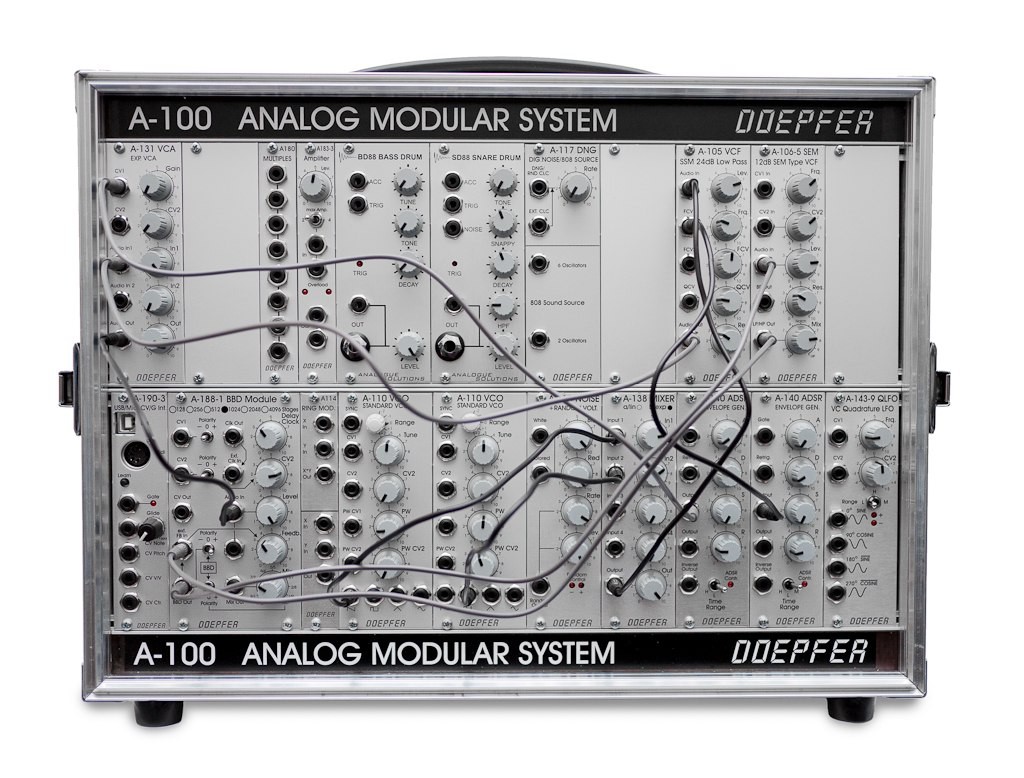This project is confusing to explain to people. Even quite technical people. Even quite technical musical people. It has layers of potential misunderstanding, like an onion which turns out to have a potato in the middle.
First, you have to explain what a modular synthesizer is. A modular synthesizer is a collection of modules which each perform a single function, either to generate an electrical signal or to alter one. The user decides how the electrical signals are routed by "patching" different modules together with audio cables. Modules conform to a standard size and voltage range, and hence can be obtained from a huge variety of manufacturers before being installed alongside each other in a single case. Here is an image of a typical modular synthesizer (image credit Nina Richards https://commons.wikimedia.org/wiki/File:Doepfer_A-100.jpg):

Modular synthesizers have experienced a renaissance in the past few years, as people are attracted to the amount of control and invention available when compared to a regular synthesizer. The other main selling point is the analogue nature of the sound - there is a feeling that using analogue oscillators, filters, and other components gives an inherent warmth to the audio.
However, it is wryly acknowledged among modular synth users that it is a very expensive way to make sounds, particularly when compared to software synthesizers. A full modular system with a keyboard is likely to cost £2000+, while extra modules can cost anything from £50 to £500+ each.
These prices put modular synthesizers out of range of younger and poorer musicians, which is a shame. There are software equivalents, such as the excellent open source project VCV Rack, but they lack the tactile interactivity of a physical synth.
This brings us to my project, the PolyMod. It is functionally almost identical to an analogue modular synthesizer. You still install individual modules in a case and patch them together to make a sound. However, rather than using an analogue signal chain, the PolyMod is basically a software synthesizer with a physical form. Here's how it works:
The PolyMod consists of a Teensy 3.6 (basically a tiny computer) and a series of modules. Each module in the PolyMod is simply a collection of sockets and potentiometers, with no audio circuitry whatsoever. When the synth is turned on, the computer scans each module to see what type it is (oscillator, filter, amplifier, etc). If the computer detects an oscillator module, for instance, it creates a virtual oscillator module in a software synthesizer.
The computer then continually listens for connections between the modules' sockets. If a patch cable is connected between the oscillator's square wave output and the synth's master stage, for instance, the software synth will also create this connection, and a square wave will be heard. If the user removes the patch cable, the software synth will delete the connection and the sound will cease.
Performing the synthesis in this way means that I was able to build a working modular synthesizer (including eight modules) for about £150. What's even more exciting is that the modules themselves only require about £4 of components each.
In a way, this is comparing apples with oranges. The appeal for a lot of serious modular synth users is, after all, the pure analogue sound, whereas the PolyMod produces all its audio digitally. However, I think the audio quality is certainly good enough to be of interest to people who couldn't afford an analogue modular setup. What's more, there is one rather exciting feature that the PolyMod has, which can't be replicated on an analogue modular synth... polyphony!
Analogue modular systems are geared towards playing one note at a time. Playing chords or harmonies (more than one note at once) is technically possible, but requires a lot of modules and an awful lot of patch cables - this discussion on a modular synth forum is a good summary of how hard it is to do: https://www.muffwiggler.com/forum/viewtopic.php?t=54757
However, an interesting side effect of the way the PolyMod works is that polyphony was actually very easy to implement! When in polyphonic mode, the PolyMod simply creates four copies of each module instead of one, and then creates four virtual audio connections every time a single physical patch cable is connected.
I hope this long ramble has cleared up exactly why I made this synth. In conclusion:
- It's cheaper to build
- It may not be analogue, but it still sounds pretty cool for the price
- It's a polyphonic modular synth, which I don't think has really been done before
 Matt Bradshaw
Matt Bradshaw
Discussions
Become a Hackaday.io Member
Create an account to leave a comment. Already have an account? Log In.